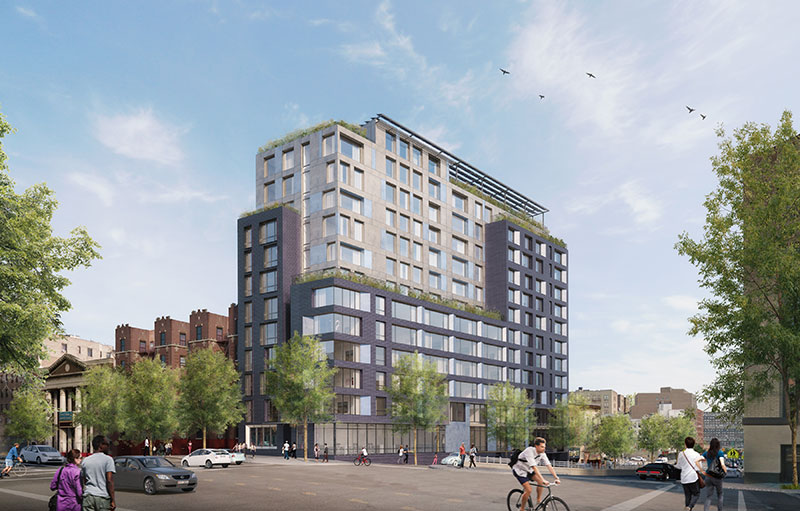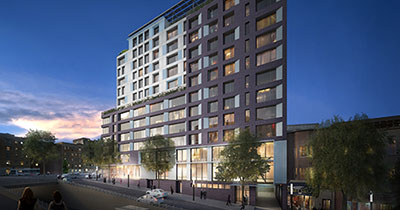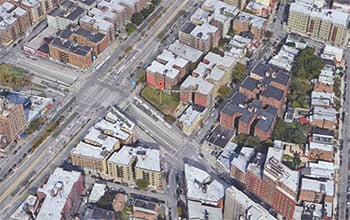2050 Grand Concourse
Bronx County

Highly efficient construction in an affordable multifamily building
Background
2050 Grand Concourse is a 13-story mixed income, multifamily building that will contain 96 units, including designated units for low- to moderate-income (LMI) households and adults with chronic illness. The design strategies will prioritize energy efficiency, sustainability, and indoor air quality.
The project’s mission is to serve unique populations in need and address climate change mitigation in the context of quality urban affordable housing. The project will meet Leadership in Energy and Environmental Design (LEED) Platinum certification, currently scoring 84 LEED-H credits. The design team is incorporating several innovative strategies to promote whole building environmental well-being, sustainable site development, water savings, energy efficiency, material selection, and indoor environmental quality. 2050 Grand Concourse employs high-performing, healthy, and sustainable strategies, exemplifying what can be achieved and replicated with similar building conditions and comparable neighborhood fabrics. The project team is deploying innovative renewable technologies; an electrified primary heating and cooling system; and close collaboration with architects, mechanical engineers, general contractors, and sustainability consultants to achieve this level of high performance.

As part of the State’s effort to achieve a carbon-neutral economy, NYSERDA initiated the Buildings of Excellence (BOE) Competition in early 2019. The competition recognizes and rewards the design, construction, and operation of very low or zero-carbon emitting multifamily buildings.

Key Project Features
Key high-performance building strategies in 2050 Grand Concourse include:
- HVAC: Variable refrigerant flow (VRF) air source heat pumps (ASHP), energy recovery ventilators (ERV).
- Water Heating: Ultra-high efficiency condensing storage water tank.
- Renewables: Solar panel array over community room roof.
- Lighting: LED, daylighting.
- Appliances: ENERGY STAR® and electric stoves.
Planning and Design Approach
Project Goals
2050 Grand Concourse will embody Unique People Service’s mission to serve unique populations in need by providing quality urban affordable housing, while also addressing climate change through the use of sustainable methodologies and energy-efficient materials. The project team is committed to leading the way in providing permanent high-performance affordable housing, and support services, for vulnerable populations in New York City.
Project Team
The project team focused on high-level collaboration and integrated design to ensure 2050 Grand Concourse employs high-performance, health, and sustainability strategies. The project team includes owner and co-developer, Unique People Services, Inc, co-developer, Robert Sanborn Development, LLC, Owner’s Representative, Olive Branch Consulting, Ltd, and architecture and design services provided by Magnusson Architecture and Planning PC. Other project team members are Johnson and Urban Consulting Engineers LLC as the mechanical, electrical, and plumbing (MEP) engineer, Terrain NYC as landscape architects, Philip Habib and Associates as civil engineers, GACE Consulting Engineers as structural engineers, Bright Power as the energy consultant, and Bruno Frustaci Construction as the general contractor.
Building Design
2050 Grand Concourse is a 13-story, 86,176 square feet (ft2) mixed income, mixed population multifamily building that will house low- and moderate-income families as well as adults with special needs. The design team is implementing a number of solutions to enhance whole-building environmental well-being, sustainable site development, water conservation, energy efficiency, material selection, and indoor air quality. A community facility space will occupy the first three floors of the building and will house the relocated headquarters and social service programs for Unique People Services, as well as community amenities for area residents and local organizations.
The project will activate the surrounding commercial corridor while respecting the historic residential nature of Grand Concourse. The building design will include green roofs, green spaces, extensive daylighting, and stormwater management. The building will have a high-performing envelope and is set to achieve LEED-H Platinum certification.
Project Details
Location:
Bronx, New York
Project Area:
86,176 sq. ft.
Number of Buildings:
1
Number of Stories Per Building:
13
Number of Units:
96
Project Cost:
$54,189,131
Cost per Gross Square Foot:
$628.84
Market Sector:
LMI
Construction Type:
New Construction
Start Date:
January 2020
Completion Date:
May 2022
REDC Region:
New York City
Developer:
Unique People Services, Inc.
Architect & Design Team Lead:
Magnusson Architecture and Planning PC
Technologies Used:
VRF, Smart buildings/monitoring focused, stone wool insulation with panelized rain screen

Predicted Site Energy Use Intensity (EUI): 34.3 kBtu/SF/yr
Net Site Energy Use Intensity (EUI): 31.7 kBtu/SF/yr
Predicted Renewable Production Intensity (RPI): 2.6 kBtu/SF/yr
Energy Code Baseline: 2016 NYS Energy Conservation Construction Code (ECCC)
Performance Path: ASHRAE
Certification: LEED for Homes Platinum
Energy Modeling
Energy modeling helped achieve a balance between energy savings and cost effectiveness. The building was modeled in eQuest using the ASHRAE 90.1-2013 baseline and is seeking ENERGY STAR® Multifamily Highrise certification. The building was modeled with 70,843 ft2 of conditioned area, which is 82% of the total building area. The model included the following parameters:
- Window assemblies were modeled with U-factors of 0.25 and solar heat gain coefficient (SHGC) of 0.27.
- The roof was modeled with a 0.03 U-factor.
- Above grade walls were modeled with a 0.05 U-factor, while the below grade wall was modeled with a 0.08 U-factor.
- The domestic hot water (DHW) system was modeled as two central gas boilers with 582 gallons of storage and 97% efficiency.
- The heating, ventilation, and air conditioning (HVAC) system was modeled with in-unit Daikin VRFs with energy efficiency ratio (EER) of 12.4 for cooling and coefficient of performance (COP) of 3.4 for heating, as well as ERVs with 80 annual fuel utilization efficiency (AFUE) gas heating and 70% energy recovery effectiveness in apartment corridors.
Additional loads include electric stoves and shared gas clothes dryers. The building was modeled with a 50-kilowatt (kW) roof solar photovoltaic (PV) system that produces 60,000 kilowatt-hours per year (kWh/yr) of on-site electricity. The proposed design shows 16% electricity savings and 72% gas savings against the baseline for an overall site energy savings of 51% and had a 32% improvement on energy cost beyond ASHRAE 90.1-2013, with renewables.
Energy-Efficient Design
Building Envelope
The envelope of the building consists of the following: (1) above grade walls with R-17 4” stone wool rigid insulation to slow the rate of heat transfer; (2) a continuous air and water vapor boundary applied behind both the brick and rainscreen metal panel cladding, exceeding the Energy Conservation Code 2016 minimum values for the given components; (3) below grade walls with R-12 stone wool rigid insulation; and (4) a roof assembly with 6” R-30 average extruded polystyrene (XPS) Rigid Insulation. To create a smooth transition between the interior and exterior of the building and limit heat loss, the project includes high-performance, National Fenestration Rating Council (NFRC) labeled fenestration. The double pane, operable unplasticized polyvinyl chloride (uPVC) windows have a U-factor of 0.27 and a SHGC of 0.27, and the fixed windows have a U-factor of 0.25 and an SHGC of 0.40.
Construction materials derived from recycled content are being carefully selected for the overall sustainability of the final built form. Examples of this include recycled brick, concrete masonry units, grout materials, framing components, and metal framing encompassed material. Both the metal framing and gypsum board will have minimum 25% post-consumer and 50% pre-consumer recycled content. In addition to implementing environmentally thoughtful materials, all wood in the building will be non-tropical or certified by the Forest Stewardship Council.
Electric Systems
While the project is not entirely electric due to its gas-powered domestic hot water (DHW) system, corridor heating, and clothes dryers, the project includes the following highly efficient electric systems:
- Apartment Heating and Cooling: VRF—ASHP.
- High-efficiency rating for all equipment, thermostats, and controls. Designed to comply with requirements of | ASHRAE Standard 62.2-2010. All supply and exhaust rates are over ASHRAE 62.1 and 62.2 (2013 values for NYSERDA New Construction Program).
- DHW: Two high-efficiency condensing boilers (AquaPLEX, Power VTX) with 97% efficiency and R-4 pipe insulation on all DHW piping, including under the slab.
- ERV: Continuous mechanical exhaust for kitchen and bathrooms.
High-Efficiency Lighting Fixtures and Appliances
2050 Grand Concourse includes the following electric, high-efficiency fixtures and appliances:
- Lighting: LED lighting with both bi-level lighting and occupancy sensors in corridors, stairs, and vestibules, and occupancy sensors in offices, storage rooms, and conference rooms.
- Water: Low-flow and WaterSense labeled bathroom toilets, kitchen sinks, and showerheads; these measures result in savings of more than 30% over baseline water energy savings analyses.
- Appliances: ENERGY STAR® appliances, with the exception of gas clothes dryers.
Renewable Energy
The project includes a proposed 50-kW solar PV system over the community room roof, consisting of 139 Sun Power 360-watt panels.
Energy Consumption Feedback and Smart Buildings Technologies
Bright Power will provide an energy management system and performance analytics for 2050 Grand Concourse through EnergyScoreCards, an energy and water analysis platform and benchmarking service that monitors consumption and cost at building levels. Paired with Bright Power’s Management of Building Information, Utilities, and Systems (MoBIUS®) real-time energy management service, this will provide actual energy monitoring and enable continuous commissioning to identify and reduce energy consumption. It will also connect the building owners and operators to energy experts.
Key elements of the building’s energy management include:
- Electricity, heating, and cooling are directly metered, and DHW and water sub metered.
- Tenants are billed for electricity, except for heating, cooling, DHW, and water.
- Supportive units are metered on a master meter with submeters, and non-supportive units are individually metered.
Building Operations
Cost Reduction
The project site is located at the corner of two roads that will not accommodate large cranes for plank picking. The logistics require using a cast-in-place, super-structure increasing costs by 20–25%. Without the extra cost associated with the concrete structure, the project’s high-performance components would increase the total cost by 3–5% compared to a standard construction project. Occupant Engagement Upon moving in, residents will be given documents explaining how to use the sustainable features of the building. Management will give occupants reminders, updates, and tutorials as necessary. Additionally, management will provide trainings throughout the year for residents to learn how to better use and understand the building technology. If issues or patterns of high consumption occur, training sessions will focus on those areas. A resident committee will be formed to provide feedback from residents, help identify emerging issues, and encourage education and participation among residents.
The lobby screen in the 2050 Grand Concourse building will show building-wide energy consumption. It will provide reminders of specific energy saving strategies, encourage proper use of building technology, and provide real-time information on local options to promote the use of public transportation.
Facility Management and Vendor Training
The building staff at 2050 Grand Concourse will be trained on all buildings systems with specific focus on sustainability and energy-efficient features. Regular maintenance and checks of the building systems will be scheduled for optimum performance. Additionally, staff will have access to operation, maintenance, and emergency manuals.


Site location for 2050 Grand Concourse, provided by
Magnusson Architecture & Planning PC
Additional Benefits
Site Context
2050 Grand Concourse is located in New York City’s borough, the Bronx. The site is well connected to public transportation with five bus stops located at the adjacent intersection and two nearby subway stations. The building is located near many amenities, including 13 parks and open spaces, multiple recreational and cultural facilities, food programs, residential facilities, senior facilities, daycares, mental health service locations, nursing homes, hospitals, public safety and criminal justice facilities, and schools within a five-block radius. The location will promote an active lifestyle for all residents.
Community Engagement
2050 Grand Concourse hopes to help specific vulnerable populations in the community. The 13-story, mixed income multifamily building that will contain 96 units, including 25 units for low-income families, 15 for moderate-income families, 30 single units for adults living with HIV/AIDs, and 25 single units for adults living with chronic mental illness. The building will offer transitional and permanent high-performance affordable housing to formerly homeless people living with chronic mental health challenges and HIV/AIDs. The 10,000 ft2 of community facility space occupied by Unique People services will provide health and social services programs for residents and the community.
Occupant Health, Comfort, and Productivity
2050 Grand Concourse design strategies prioritize energy efficiency, sustainability, and indoor air quality. The design includes continuous, filtered, balanced ventilation for ideal air quality in all spaces. Residents will have programmable thermostats, access to abundant daylight and exterior views in all dwellings and bedrooms, and access to green and recreational spaces integrated on site.
Resiliency
The project team focused on implementing green infrastructure in the design. Stormwater management techniques were designed to manage water from rainfall events to reduce runoff and collect irrigation. These techniques included the installation of green roof trays at setback roofs to reduce storm water runoff. The cistern in the yard then collects the stormwater from the roofs to be used for irrigation. There are also separate detention tanks on site that will collect unused stormwater to even out peak flows in the system, avoiding overflow and protecting downstream areas. This design approach and infrastructure creates the on-site wastewater management system. Additionally, the roof will be high albedo to reduce heat island effect and include ENERGY STAR® qualified roof products.
The passive survivability of the building allows it to maintain comfortable conditions for longer periods of time, even without active mechanical conditioning. The hot water high-efficiency boilers and emergency generator are located on the roof to ensure vital building services can still operate in the case of flooding. Additionally, on-site renewables ensure energy availability in the event of a grid power outage.
Lessons Learned
- Integrated design is a critical aspect of ensuring that the project team prioritizes the environmental and social design components. This includes the early, frequent, and close collaboration of architects, mechanical engineers, general contractors, and sustainability consultants to achieve this level of high performance.
- The 2050 Grand Concourse team is committed to leading the way in offering permanent high-performance affordable housing for low- and moderate-income families and adults with special needs. This is accomplished by designating units for specific populations and providing on-site resources and assistance. For additional information learn more at UniquePeopleServices.org
 .
.
Ready to get started?
Contact NYSERDA at [email protected] to learn how you can reduce energy consumption and costs.

